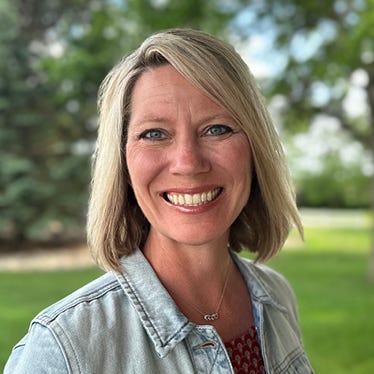March 29, 2024

TEST IT OUT: Nebraska Tractor Test Laboratory engineer Doug Triplett talks about the current NTTL test car, which was built by Caterpillar and is used in testing tractors at the test track at NTTL on East Campus at the University of Nebraska in Lincoln. Holly Wortmann
At a glance
Tractor test lab started because of a disgruntled farmer.
Established in 1920, a Waterloo Boy Model N was the first tractor tested there.
NTTL is the gold standard as a testing facility for the world.
The Nebraska Tractor Test Laboratory (NTTL), located on East Campus at the University of Nebraska- Lincoln, is at the helm of many key international developments in tractor technology performance and power standards.
And it all began with a frustrated early 20th-century farmer.
It was 1916. Wilmot Crozier, of Osceola, Neb., was dissatisfied with the performance of his Ford Model B tractor (no connection to the company founded by Henry Ford). He found his tractor undependable and had trouble getting parts and maintenance.
“Crozier was buying tractors that weren’t meeting their claims,” NTTL test engineer Justin Geyer says. “They weren’t doing what they were supposed to. And then there were other tractors that were exceeding [farmer expectations and company claims].”
Geyer, a UNL alum, worked as a student employee at the test lab and returned in 2012 as a research test engineer.
There should be a law
In 1919, Crozier was elected to the Nebraska state legislature and advocated for a bill requiring that any model of agricultural tractor sold in the state must verify its advertised performance claims. The Nebraska Tractor Test Act was passed, and the law still exists today with very few modifications from the original bill.
NTTL was established in response to requirements of that bill. “They didn’t mess around,” Geyer says. “They got started right away.”
The requirements included testing advertised claims, having at least one tractor parts warehouse and one repair facility in Nebraska, obtaining permits to sell tractors issued by the State Railway Commission (now the Department of Agriculture), and establishing a board of engineers at the university to develop the test procedures and review all test results.
The first tractor test, involving a John Deere predecessor called Waterloo Boy Model N, was completed on April 9, 1920.
In the early years, tractor testing consisted of measuring claims for drawbar and belt horsepower and fuel consumption. For belt horsepower measurements, the flat-belt drive on the tractor was connected to a dynamometer. The dynamometer is a generator, so as the tractor turned the stator, it generated electrical energy.
A scale and lever arm were used to measure torque produced. The stator speed also was measured, allowing the tractor's horsepower to be calculated. As the load changed, it was determined how hard the tractor had to work. For drawbar testing, a load car was built by adding a portable dynamometer to a tractor frame that was then pulled in reverse.
Same procedures
Much of the tractor testing today is identical to the procedures of the original laboratory. Among the tests conducted are power-take-off (PTO) tests, drawbar tests, rollover protective structure tests and tests of sound levels in tractors. “It used to be agricultural walk-behind tractors starting at 1.4 horsepower,” Geyer says. “Now it's 100 HP and above. On average, we test 20 tractors a year, and sometimes 15 in a season. We could have a 75-HP tractor and a 700 HP in the same season, so we need to be pretty flexible.”
Roger Hoy is the director of NTTL and a professor in the UNL biological systems engineering department. “Something that makes NTTL unique is that we’re on a university campus,” Hoy says. “We have the opportunity to allow our students to participate in our work and to learn the profession that will be expected of them when they leave the university. That’s something UNL offers that no other college in the world that I’m aware of can offer.”
“We’ll hire 15 to 25 students, and they’ll come down and work for a couple hours. It's good for them, and then they go out and work for AGCO, Deere or Case and have an advantage,” Geyer says.
Like Geyer, Doug Triplett attended UNL and returned to NTTL in 2012 as a test engineer. “When the tractor manufacturer comes to the lab, we usually start inside on a PTO dynamometer. That’s usually where the horsepower claim is,” Triplett explains. “Most manufacturers that come here actually run this test before they bring the tractor, so they know what they’re going to get.”
Backing up the claims
“We’re following all the same rules as the law, so if they make a claim on any of their advertisements or anything, they need to come down here and prove [it],” Triplett says. “If they can’t meet that claim, they will not be issued a permit to sell that tractor in Nebraska without redoing advertisement claims. If they have already sold one, they have to go out and find out who they sold it to and reimburse or exchange that tractor for something else. So we hold the numbers pretty tight here.”
All the data from the various tests are consolidated in a standardized report called the Nebraska Summary. “We offer to the public a free report for every tractor that we’ve tested — we’ve had about 2,300 models since 1920,” Geyer says. “For everything that's tested here, it's usually three to five pages and has all the results and important points that have been tested, such as fuel consumption, PTO, engine size, tire size and weight. We still use files, but on the test lab website, there is a searchable database of every tractor that has been tested here.”
NTTL was the first testing center of its kind in the world and has served for decades as the official designated tractor testing station for the U.S. In 1986, NTTL joined the Organization for Economic Cooperation and Development. Tractor performance is measured according to OECD codes, which are conformed to by 34 countries. Cooperation agreements with the codes require that once an OECD test report is officially approved, it must be accepted by all participating countries.
Nebraska has made significant contributions to writing the codes and updating them. “I would say we are the most respected OECD tractor-testing station in the world, and we are the granddaddy of them all,” Hoy says.
Gold standard
“Our testing has become the gold standard around the world,” Geyer agrees. “We offer consistency in the same location and same process rather than different companies and different labs. One of the perks for the manufacturers is that there’s a common measuring stick. That’s one thing that keeps us around. It's unique because we’re kind of a police force in that regard.
“Back in 1919, when Nebraska legislature passed the tractor test law, the common thinking at that time was that we weren’t going to be around that long and, essentially, we were only going to operate for a few years and get all the disreputable manufactures out of business and leave only reputable manufacturers, and the need would go away,” Hoy says. “What happened instead with the reputable manufacturers was that they started competing on the numbers that were generated in Nebraska. And they still do that today.
“There are two bases for that. One is the marketing piece within the companies, but the one that’s more relevant to NTTL is that we have always been able to be as unbiased as possible in what we publish in our test reports. We’ve managed to maintain a reputation of a reliable source of data for over a century now. And I think that’s our biggest key to long-term success.”
Learn more at tractortestlab.unl.edu.
Wortmann writes from Crofton, Neb.
About the Author(s)
You May Also Like






